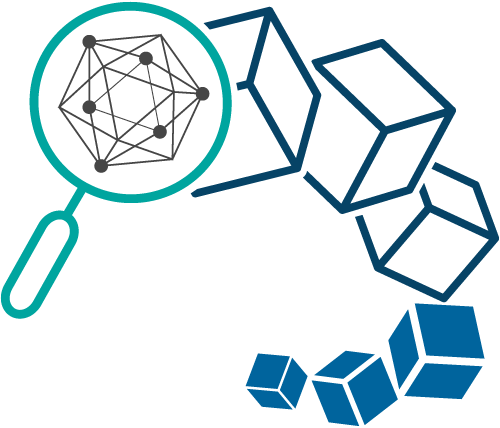Database Specialities
Powerful Web & Database Development capabilities.
Technologies

Structured Query List, or SQL, is a programming language used specifically for storing, and querying data within a database table.
SQL is used for nearly all website and web app database development and frameworks, including our available PHP web applications.
For our Linux-based solutions, both managed and on-premise projects use the MariaDB open source framework to host SQL Databases within a Linux device.
Depending on the project and the available hardware, SQLite can be used as a substitute for a MariaDB Database as SQlite is a small, self-contained database engine for low-powered hardware. Most mobile phone devices run operating systems on the SQLite framework.
HyperLedger is a new technology released by IBM and the Linux Foundation, used specifically for enterprise decentralized solutions by means of creating a Blockchain framework for storing data.
Unlike most Blockchain applications which exist now, HyperLedger is designed specifically to be applied to industry as a store of data, rather than a financial asset or medium.
Some example use-cases of HyperLedger include:
- Tracking of agriculture or fisheries stored on a distributed ledger
- Motor vehicle registration and service history
- Employment contracts
- Inventory management
- Tracking original source of precious metals and gemstones
A highly complex albeit powerful database development tool is the development of an ERC20 token on the Ethereum network.
The ERC20 token is an interface for interchangeable tokens such as a voting token, staking or virtual currency token.
Such data systems are functional for very specific use cases where the usage of the data system is extremely well-defined, and will never change its use case.
ERC20 tokens are highly useful with wep app programs which seek to reward content creators and professional services by means of an interchangeable token based on pre-configured rules in its smart contract, which is then stored as data on its distributed ledger.
Examples of ERC20 token use cases include:
Security

Data Fidelity has made available their E-Book online which can be accessed here.
For WordPress websites, Data Fidelity uses the WordFence application to actively monitor all hosted sites.
WordFence is a global network of apps running as an endpoint firewall, operating synchronously with real-time reporting available.
WordFence adopts a proactive approach to site security and potential security flaws by recording any breaches across the global wordfence network, and automatically providing patch updates once a new cyber threat to WordPress sites has been identified.
In addition to this, Wordfence also provides Geoblocking either by individual IP address, country or region, to prevent unwanted traffic from other countries if required, and logs all successful site logins with both the IP address, and the username.
Data Fidelity receives weekly security audits for all hosted sites containins potential security flaws, which are immediately patched and updated.
Website/Web app Blacklisting/Whitelisting is a very powerful tool when operating a Database containing potentially sensitive, critical information.
Whitelisting is the process of filtering only specific IP addresses (Or MAC addresses for very secure, tightened security to an extreme point).
Blacklisting is preventing access to a network based on IP address.
Whitelisting is recommended for internal use database development and systems, as whitelisting prevents all access other than those whitelisted IP addresses; Blacklisting is recommended for specific security needs for a publicly available database as it will allow open access other than those blacklisted.
For Database development, Data Fidelity always recommends conducting a Penetration test.
A Pen Test is an attempt to ‘hack’ a network, or device, containing the sensitive data; The purpose of the pen test is to identify any potential weaknesses in the network or device, and then reporting on the findings to make recommendations to improve security.
We use a series of tools for pen testing:
- Kali Linux, has all pen testing tools pre-installed. We run Kali Linux in a Virtual Machine to conduct pen testing.
- WPscan is a scanning tool which has the ability to scan a website to be built with WordPress, and if so, provides a report on outdated and insecure plugins, database configurations or scripts.
- NMap, although not built specifically for pen testing, does provide the ability to scan a network and all ports on the network, to identify any open ports which can potentially provide a means of breaching a network by open network port.
- Metasploit is a comprehensive framework of known system vulnerabilities which once access to a network has been made, can scan all connected devices, identify their operating systems, build numbers and provide a report on all known weaknesses across all network connected devices. Metasploit then has the ability to deliver a payload to a victim device.
Although Data Fidelity uses comprehensive pen testing tools, we always recommend using best-practice when using any network or computer devices; The largest cause of successful network breaches is human error resulting from weak passwords that are easily guessed, phishing attempts or lack of physical security around a server (no lockable doors).
Database Development should always be done in conjunction with best practice, and kept secure; Databases almost always contain sensitive information such as credit cards, addresses, emails, phone numbers and other personal identifying information for our clients, or their own clients, and we always take Database security very seriously.
Automated patch updates are a tool that Data Fidelity uses to automatically update all website extensions, server tools and plugins to the latest version; As this is automated, it prevents any lapse in time between when a system has become vulnerable to when patches are installed.
Redundancy

RAID, or Redundant Array Of Inexpensive Disks, is a configuration of one or more hard drives acting in unison as a single storage drive on a PC.
The purpose of RAID is as a redundancy to protect data, in the event that a hard drive fails. By copying data across multiple drives, this greatly eliminates the risk of loss of data in the event that a hard drive fails.
Rsync is a very powerful software tool developed by GNU. Rsync is the synchronization of two or more files, or two or more file directories, between two file directories, computers, servers or networks.
Data Fidelity consistently uses Rsync to synchronize data between locations. When used in conjunction with RAID, in the event that a server has total catastrophic loss, such as a fire or flood, data can be backed up securely off site via Rsync.
A Cron job is a job which runs a command continuously, or repeatedly over a designated time period. This means, as an example, that an Rsync command can be run every hour, or every day, to conduct a backup of a filesystem.
FTP, or File Transfer Protocol, is the means of providing access to a remote devices file systems.
FTP is commonly used with websites to be able to explore a websites files remotely, by completing tasks on a website, without directly accessing the website itself.
This is very useful for teams who are sharing file directories without the use of big tech, as it provides access to a single store of files to one or more people.
Physical redundancy refers to the physical backup of important data, such as using an off-site network attached storage (NAS) device, or portable hard drive.
Data Fidelity uses both NAS and portable hard drives as backup options to sensitive data.
When used in conjunction with the above systems (RAID, Rsync, FTP) a storage of data has the capacity to be secured and backed up against loss of network, theft, natural event (fire or flood) or component failure.
Accessibility

Accessing your website and/or web apps is easiest done via an admin portal.
A default WordPress admin portal is at the wp-admin.php page, which gives site admin access to product orders, pages, plugins, security or updates.
Other web apps such as Rainloop, Akaunting, SuiteCRM or Nextcloud also have similar admin access portals, which enable permissions to be set for groups, individuals or visitors, as well as web app branding & management.
Cpanel hosting, when applicable, is the means of a web portal providing access to a full suite of tools used for a web hosting platform and everything that is installed on the platform.
Cpanel includes available settings such as:
- Web app installations (new or existing)
- File directories
- Domains & subdomains
- PHP options
- Backup configurations
Enabling FTP access to your website or web app is useful when there is limited access to a website without cpanel acess, or without site admin access.
Many times, FTP access is a useful insurance policy as in the event that a website has a potential script conflict and an error 500, without cpanel access, this can be resolved by means of rewriting or removing conflicting files via FTP.
Providing network access to the hosting platform is very useful for highly scaleable web apps, where custom scripts and functions are built onto the hosting platform.
Data Fidelity commonly uses this method for managed Linux apps without a General User Interface (GUI) to create scripts, install softwares or check security by means of a Linux Terminal & using Nano, a very popular open-source Linux text editor developed by GNU.

